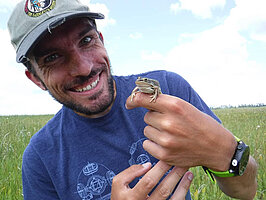Landscape Genetics of Northern Leopard Frog (Rana pipiens) to Evaluate Biotic Connectivity and Environmental Quality of North Dakota Wetland Resources

Justin Waraniak is a PhD student in the Environmental & Conservation Sciences Program at North Dakota State University. He holds a Master's in Fisheries and Wildlife from Michigan State University and a Bachelor's of Science in Ecology and Evolutionary Biology from the University of Michigan. He is interested in molecular ecology, using genetic tools to better understand how the biotic components of an ecosystem interact with their environment and with each other. His current research focuses on the landscape genetics of northern leopard frogs.
Fellow: Justin Waraniak
Advisor: Dr. Craig Stockwell, Department of Biological Sciences, North Dakota State University
Landscape Genetics of Northern Leopard Frog (Rana pipiens) to Evaluate Biotic Connectivity and Environmental Quality of North Dakota Wetland Resources
In this project, microsatellite genotypes of northern leopard frog populations around the state of North Dakota were analyzed. It was discovered that the population structure of R. pipiens was strongly associated with river basins and that the Missouri River acted as a major barrier restricting gene flow between populations on different sides of the river. It was estimated that the population division caused by the Missouri River occurred ~18,000 years ago as glaciers receded out of northeastern North Dakota. Population subdivisions by river basin were estimated to occur mostly between 8000 - 5000 years ago during the mid-Holocene. This was a period characterized by extreme droughts in the Northern Plains, which isolated R. pipiens in deep-water habitats causing the population substructuring by the river basin. This research forms an important baseline of knowledge to conduct more fine-scale genetic analyses of R. pipiens populations in North Dakota. Field sampling of R. pipiens in North Dakota was completed to examine the ecological and evolutionary impacts of intensive agriculture on populations. Tissue samples for genomic analysis were collected from 632 frogs at 36 sample sites across the state. DNA extractions from these samples were completed. The SNP markers were used to detect signatures of selection due to compromised water quality in areas with intensive agriculture, to estimate the rates of gene flow and identify habitats important for biotic connectivity in the Prairie Pothole Region, and to infer demographic history.
Progress:
We are conducting field sampling and collecting genetic material from frogs in the across North Dakota. We are sampling frogs from four distinct ecoregions: the Prairie Potholes, the Lake Agassiz Plain, the Badlands, and Turtle Mountain to compare morphologies of the different frog populations that reside in each of the ecoregions as well as look for signatures of local adaptation. Additional samples are being collected from sites in the James and Lake Oahe river basins to identify possible selective pressures put on amphibians due to agriculture. The sampling scheme of these sites was also designed so we would be able to compare how frogs move through landscapes dominated by cultivated crops and natural grassland.
Significance:
North Dakota has incredibly abundant wetland resources, but these are under threat due to expanding agriculture and climate change. Understanding how wetland-dependent animals, like northern leopard frogs, are affected by various features on the landscape can help determine which habitats are crucially important for conservation and restoration. This study also features a rare opportunity to investigate whether living in areas with intensive agriculture has had a lasting impact on the genetic makeup of sensitive frog populations.
Research Outcomes:
Waraniak JM, Fisher JDL, Purcell K, Mushet D, Stockwell CA. (In review). Landscape genetics reveal broad and fine scale population structure due to climate and colonization history of the northern leopard frog in North Dakota. Ecology & Evolution.
Landscape genetics reveal possible drought and Ice Age refugia drive population subdivision of northern leopard frog in North Dakota. Justin Waraniak, Justin Fisher, Kevin Purcell, David Mushet, and Craig Stockwell. Oral Presentation at the 2017 Society of Wetland Scientists Northern Prairie Chapter Meeting, Fargo, ND.
Landscape genetics reveal possible drought and Ice Age refugia drive population subdivision of northern leopard frog in North Dakota. Justin Waraniak, Justin Fisher, Kevin Purcell, David Mushet, and Craig Stockwell. Oral Presentation at the 2018 Midwest Fish and Wildlife Conference, Milwaukee, WI.
Landscape genetics reveal possible drought and Ice Age refugia drive population subdivision of northern leopard frog in North Dakota. Justin Waraniak, Justin Fisher, Kevin Purcell, David Mushet, and Craig Stockwell. Oral Presentation at the 2018 Wildlife Society - North Dakota Chapter Meeting, Bismark, ND.

Craig Stockwell
Biological Sciences
Office: Stevens 119
Telephone: 701-231-8449
Email: craig.stockwell@ndsu.edu


